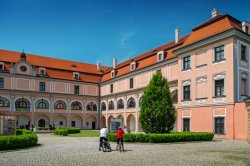Chateau Kinských
In the town of Valašské Meziříčí itself, we can find the Renaissance Žerotín chateau, the construction of which began during the first half of the 16th century by Jan of Pernštejn. In 1648, the building was damaged by raids by Swedish troops, so at the beginning of the 18th century it was necessary to carry out a Baroque reconstruction, initiated by the then owner, Ludvík of Žerotín. At that time, the castle almost acquired its current appearance.
Information for visitors
Interesting facts Chateau Kinských
During the reconstruction, the south wing was built and the north wing was extended. The courtyard was decorated with arcades.
In 1815, the then owner Marie Josef of Žerotín sold the Valašské Meziříčí estate to František Josef Kinský of Vchynice and Tetovo. The Kinský family then owned the estate until 1854, when they moved to the chateau in Krásno nad Bečvou, so they sold their estate in Valašské Meziříčí to the state.
From 1854 the chateau served as a state prison, during the First World War as a military hospital and finally a barracks. In 1913, the Archbishop of Olomouc František Saleský Bauer became the owner of the chateau, who acquired it for the Catholic House Association, and had the northern part of the chateau rebuilt into a theater hall and federal rooms. After the Second World War, the chateau was owned by the MNV and was the seat of the workers' club.
At the end of the last century, the Valašské Meziříčí chateau underwent extensive reconstruction, thanks to which the chateau courtyard was opened in 2002 and one of the most beautiful facilities of its kind in the Czech Republic, reserved for the M-club, was built in the basement.
At present, the chateau has the form of a two-storey three-wing building with two permanent exhibitions. The first exhibition focuses on lighting glass and tapestries, the second on how people lived in the castle and includes period-furnished castle rooms.
Author: Andrea Štyndlová

